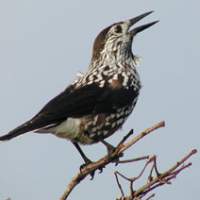* Japanese name: Hoshigarasu
* Scientific name: Nucifraga caryocatactes
* Description: Nutcrackers are members of the Corvid (crow) family. An adult bird is approximately the size of a jackdaw, with a wingspan of 17.5-19 cm and a body length of 32 cm. They weigh 155-215 grams. Like other crows, their plumage is dark, but in nutcrackers, the body is covered in white spots. When these birds are in flight, a striking black-and-white undertail pattern can be seen.
* Where to find them: Coniferous mountain forests. Nutcrackers are active during the day. Their nests are built of twigs and can be seen in pine trees. During the breeding season, nests will contain 3-4 light-blue eggs.
* Food: Insects (beetles and wasps), worms, millipedes, slugs and snails -- and, of course, nuts and pine cones. The nutcracker's sturdy bill is long and sharp, well able to penetrate and break open pine cones and remove the seeds. They have a special pouch under the tongue that is used to store and carry seeds. Nutcrackers can be remarkably tame, especially in winter, taking food from the hand and sometimes stealing campers' food.
* Special features: Like other members of the crow family, nutcrackers are smart, with well-developed brains. In the nutcracker's case, the hippocampus (the part of the brain involved in memory) is especially large. This is not surprising, as nutcrackers collect nuts and pine seeds and bury them at hundreds and even thousands of locations over a large area. The birds must remember where the food caches are in order to find them in the winter. They bury up to 100,000 seeds, but despite the large hippocampus, many are forgotten. These seeds may germinate, and so nutcrackers provide a good dispersal service to trees they feed on. Because of this readily available food supply, nutcrackers are able to start breeding in winter, when food for other birds is in short supply. Interestingly, males help incubate the eggs, which other male members of the crow family do not do. Chicks leave the nest after about three weeks and the birds live for around a year and a half. PHOTO COURTESY OF BIO-IMAGE NET
19 mins ago

















With your current subscription plan you can comment on stories. However, before writing your first comment, please create a display name in the Profile section of your subscriber account page.